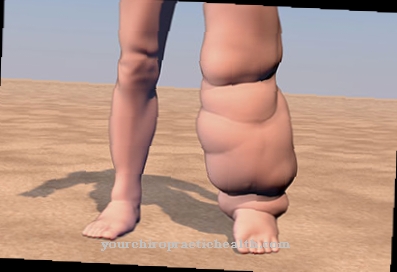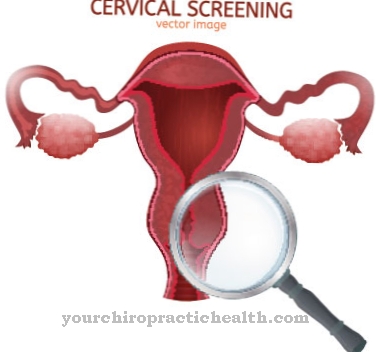The Rubella embryo fetopathy is a rubella disease of the fetus. The infection is transmitted through the placenta to the fetus and causes severe malformations. The vaccination prophylaxis against rubella is strongly recommended before pregnancy.
What is rubella embryo fetopathy?

© Zffoto - stock.adobe.com
The rubella virus is a human pathogenic virus from the genus Rubivirus, which belongs to the togaviruses. It is the only pathogenic agent in this genus. The virus is better known as the cause of rubella. In addition to rubella, infection with the virus can also be Rubella embryo fetopathy of the womb if the mother becomes infected during pregnancy.
Rubella embryopathy is consequently caused by the transfer of the rubella pathogen to the fetus as it can take place via the placenta. Infection of the fetus is a serious complication of maternal rubella and is also known as a serious pregnancy complication. The incidence of rubella embryopathy has now dropped significantly and is now only one case in 10,000 births.
It is thanks to the low incidence of the extensive MMR vaccination and the consistent prenatal diagnosis. There is a higher risk of rubella embryo fetopathy in the first trimester of pregnancy than in later stages. If the expectant mother becomes infected in the first three months of pregnancy, diaplacental transmission occurs in almost a third of all cases. Rubella embryo fetopathy results in more or less severe malformations of the fetus, which can extend from the central nervous system to over the heart.
causes
If an expectant mother becomes infected with the rubella virus during pregnancy, the virus can spread in general throughout the body. This generalized spread extends to the placenta. The virus can then be transmitted to the fetus via the placenta. The infection causes disturbances in the division of cells in the fetus.
The differentiation processes of the cells are disturbed and individual tissues do not develop as intended. Depending on the phase of embryonic development, this connection can lead to an abortion, especially if the undesirable development basically means that the individual is not viable. If there is no abortion, the infection develops into so-called embryopathy in the form of rubella syndrome.
The pregnant woman can remain completely asymptomatic if the infection is usually mild. However, this asymptomatic of the expectant mother does not allow any statements to be made about the child's condition. Infections after the third month of pregnancy are relatively rare at ten percent. In the first month of pregnancy, on the other hand, there is around a 60 percent risk.
Symptoms, ailments & signs
Rubella embryopathy causes a variety of malformations, especially in the organ systems of the central nervous system, the ears and the heart. In addition to [mental retardation]], rubella embryo fetopathy manifests itself particularly often in hepatosplenomegaly and hepatitis.
Petechiae, pronounced microcephaly or encephalitis are also present. A particularly common symptom is also the congenital heart defect in the form of a ductus botalli apertus, pulmonary stenosis or a Fallot tetralogy. Myocarditis is also possible.
In addition, the eyes can be affected by congenital functional impairments. This is the case, for example, with glaucoma, which leads to blindness over time. There is also often cataract in the eye area. The same goes for retinal malformations. The ears are also often affected by functional impairments, especially inner ear hearing loss or deafness.
Growth retardation is common. Classically, not all of the symptoms mentioned are present, but rather the patients suffer from a triad of congenital heart defects, cataracts and inner ear deafness. The severity of the malformations differs from case to case. In particularly severe cases, there is no longer any viability and the child dies in the womb.
Diagnosis & course of disease
Prenatal diagnosis is one of the reasons why the incidence of rubella embryo fetopathy is declining. If the mother gives anamnestic information, the gynecologist will order evidence of the virus in the mother's blood, urine or saliva. Further diagnostics are only required if there is no evidence that the mother has had two rubella vaccinations.
IgM detection in newborns is possible from about the fifth month of pregnancy. PCR detection can be provided by analyzing the amniotic fluid. Rubella embryo fetopathy is usually diagnosed before the child is born. The prognosis depends primarily on the stage of pregnancy when infected.
Complications
In the worst case, rubella embryo fetopathy can lead to the death of the child. For this reason, this disease must be diagnosed and treated at an early stage. The affected children usually suffer from a heart defect and are therefore dependent on regular examinations in their lives in order to avoid sudden cardiac death and other heart problems. Hepatitis can also occur in patients and have a very negative effect on quality of life.
Sometimes hearing problems or blindness can occur in the course of the child's development. The patients often suffer from significantly delayed development and are therefore dependent on the help of other people in their lives. Furthermore, mental retardation can also occur. In serious cases, the children die immediately after birth because they are unable to survive.
As a rule, rubella embryo fetopathy can be prevented well with the help of medication before pregnancy. There are no particular complications. With the help of regular examinations, the disease can be detected early and treated immediately, even during pregnancy. This completely avoids the discomfort.
When should you go to the doctor?
Rubella embryo fetopathy should always be evaluated and treated by a doctor. In the worst case, this can lead to the death of the child or serious deformities, which can lead to further complications. The earlier rubella embryo fetopathy is recognized, the higher the likelihood of a complete cure for this disease. A doctor should then be consulted if the person affected develops hepatitis during pregnancy. Heart problems can also indicate this condition and should be examined by a doctor.
In children, rubella embryo-fetopathy manifests itself as delayed growth and visual or hearing problems. In some cases it can also result in complete deafness or blindness. If these symptoms occur, a doctor must be consulted in any case. Rubella embryo fetopathy can be diagnosed by a pediatrician or a general practitioner. For further treatment, however, visits to a specialist are necessary. It cannot generally be predicted whether rubella embryo fetopathy will lead to a reduced life expectancy.
Treatment & Therapy
After a diaplantic transmission of the rubella infection to the fetus, causal therapy is no longer possible. Prevention is the crucial moment in rubella embryopathy. The maternal vaccination protection should be ensured. Before each planned pregnancy, a rubella titer should be taken.
In the event of insufficient vaccination protection, follow-up vaccinations are to be ordered. Ideally, women who are already pregnant are not vaccinated. The life vaccine can cause infection in the unborn child. Nevertheless, in an emergency, some pregnant women are still vaccinated. The infection by the vaccine virus is the lesser of two evils compared to rubella embryopathy. As a rule, the vaccine virus itself does not lead to embryopathy.
Pregnant women should not come into contact with those infected with rubella. If contact cannot be avoided, passive immunization is induced. If the mother is found to have IgG antibodies, there is presumably immunity from previous vaccination or illness.
The affected person should be checked regularly for fresh infections at least until the end of the fourth month of pregnancy. If the mother becomes infected by the fourth month of pregnancy and the parents-to-be cannot accept the foreseeable deformities of the child, an abortion can be considered.
prevention
The most effective prevention of rubella embryo fetopathy is to vaccinate the mother against rubella. The measles, mumps and rubella vaccination takes place for the first time in the first year of life and again in the fifth year of life. The titer for rubella antibodies is ideally determined before each planned pregnancy so that further vaccinations can be carried out if necessary.
Aftercare
Since rubella embryo fetopathy is a congenital malformation syndrome, there is no direct follow-up recommendation. The problems can only be treated symptomatically, but not causally. In connection with the desire to have children, detailed genetic counseling is useful. Comprehensive, loving care is important for those affected.
The parents should arrange for permanent care and the other family members can also participate. With intensive care, the course of the syndrome can be alleviated somewhat, and this also means fewer complications. This positive influence is further promoted by regular medical checks.
The responsible doctor can determine possible further damage to the organism at an early stage and act in good time. Due to the psychological strain on the affected patients and their families, it is advisable to seek professional psychotherapeutic help if necessary. Talking to family and close friends can also alleviate the difficulties.
In self-help groups or through the attending physician, the families find contact with other affected persons. The exchange that takes place here enables everyone involved to talk about the problem and to consult with solutions that make everyday life easier. This allows the beginning of depression or serious psychological difficulties to be dealt with quite well.
You can do that yourself
Pregnant women should be informed about possible risks, dangers and influencing factors of pregnancy. Your own behavior must be optimized and should be designed in the interests of the unborn child.
For this reason, surroundings and contact with people who have rubella should be avoided completely. The condition is considered highly contagious and can lead to serious complications during pregnancy. The expectant mother should therefore find out in good time which diseases are present in her immediate vicinity. Places where people diagnosed with rubella have stayed should be avoided at all costs. Consultation with a doctor is essential as soon as the first signs or irregularities appear.
The self-help measures are not enough to bring about relief from the symptoms or a cure. Only precautionary measures can be taken against the viral disease. We recommend working with a doctor even before planning the offspring. If the mother wishes to have children, he or she can assess the state of health of the mother at an early stage and, if necessary, administer vaccination protection. In addition, advice is given in good time about special situations with certain risks. Since a woman who is already pregnant cannot be vaccinated, it is particularly important and advisable to take the preliminary measures.






-eisenmangelanmie.jpg)





.jpg)



.jpg)










.jpg)
